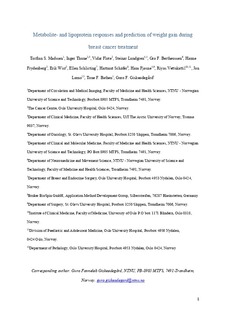| dc.contributor.author | Madssen, Torfinn Støve | |
| dc.contributor.author | Thune, Inger | |
| dc.contributor.author | Flote, Vidar Gordon | |
| dc.contributor.author | Lundgren, Steinar | |
| dc.contributor.author | Bertheussen, Gro Falkener | |
| dc.contributor.author | Frydenberg, Hanne | |
| dc.contributor.author | Wist, Erik | |
| dc.contributor.author | Schlichting, Ellen | |
| dc.contributor.author | Schäfer, Hartmut | |
| dc.contributor.author | Fjøsne, Hans Erikssønn | |
| dc.contributor.author | Vettukattil, Muhammad Riyas | |
| dc.contributor.author | Lømo, Jon | |
| dc.contributor.author | Bathen, Tone Frost | |
| dc.contributor.author | Giskeødegård, Guro F. | |
| dc.date.accessioned | 2019-04-02T06:24:27Z | |
| dc.date.available | 2019-04-02T06:24:27Z | |
| dc.date.created | 2018-12-17T15:58:16Z | |
| dc.date.issued | 2018 | |
| dc.identifier.citation | British Journal of Cancer. 2018, 119 (9), 1144-1154. | nb_NO |
| dc.identifier.issn | 0007-0920 | |
| dc.identifier.uri | http://hdl.handle.net/11250/2592790 | |
| dc.description.abstract | Background
Breast cancer treatment has metabolic side effects, potentially affecting risk of cardiovascular disease (CVD) and recurrence. We aimed to compare alterations in serum metabolites and lipoproteins during treatment between recipients and non-recipients of chemotherapy, and describe metabolite profiles associated with treatment-related weight gain.
Methods
This pilot study includes 60 stage I/II breast cancer patients who underwent surgery and were treated according to national guidelines. Serum sampled pre-surgery and after 6 and 12 months was analysed by MR spectroscopy and mass spectrometry. In all, 170 metabolites and 105 lipoprotein subfractions were quantified.
Results
The metabolite and lipoprotein profiles of chemotherapy recipients and non-recipients changed significantly 6 months after surgery (p < 0.001). Kynurenine, the lipid signal at 1.55–1.60 ppm, ADMA, 2 phosphatidylcholines (PC aa C38:3, PC ae C42:1), alpha-aminoadipic acid, hexoses and sphingolipids were increased in chemotherapy recipients after 6 months. VLDL and small dense LDL increased after 6 months, while HDL decreased, with triglyceride enrichment in HDL and LDL. At baseline, weight gainers had less acylcarnitines, phosphatidylcholines, lyso-phosphatidylcholines and sphingolipids, and showed an inflammatory lipid profile.
Conclusion
Chemotherapy recipients exhibit metabolic changes associated with inflammation, altered immune response and increased risk of CVD. Altered lipid metabolism may predispose for treatment-related weight gain. | nb_NO |
| dc.language.iso | eng | nb_NO |
| dc.publisher | Springer Nature | nb_NO |
| dc.title | Metabolite and lipoprotein responses and prediction of weight gain during breast cancer treatment | nb_NO |
| dc.type | Journal article | nb_NO |
| dc.type | Peer reviewed | nb_NO |
| dc.description.version | acceptedVersion | nb_NO |
| dc.source.pagenumber | 1144-1154 | nb_NO |
| dc.source.volume | 119 | nb_NO |
| dc.source.journal | British Journal of Cancer | nb_NO |
| dc.source.issue | 9 | nb_NO |
| dc.identifier.doi | 10.1038/s41416-018-0211-x | |
| dc.identifier.cristin | 1644447 | |
| dc.description.localcode | This is a post-peer-review, pre-copyedit version of an article published in British Journal of Cancer. Locked until 7 May 2019 due to copyright restrictions. The final authenticated version is available online at: http://dx.doi.org/10.1038/s41416-018-0211-x | nb_NO |
| cristin.unitcode | 194,65,25,0 | |
| cristin.unitcode | 194,65,15,0 | |
| cristin.unitcode | 194,65,30,0 | |
| cristin.unitname | Institutt for sirkulasjon og bildediagnostikk | |
| cristin.unitname | Institutt for klinisk og molekylær medisin | |
| cristin.unitname | Institutt for nevromedisin og bevegelsesvitenskap | |
| cristin.ispublished | true | |
| cristin.fulltext | postprint | |
| cristin.qualitycode | 2 | |
